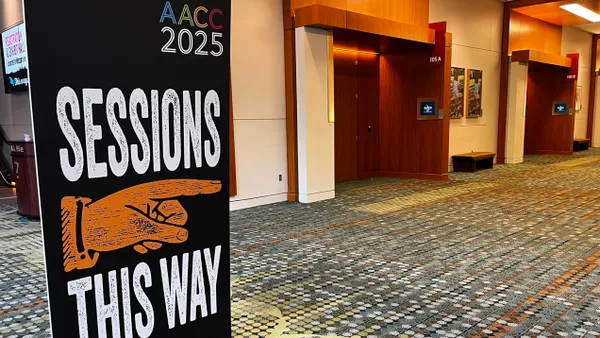Dive Brief:
- College faculty are concerned the pandemic is widening gaps in student success and equity, per a recent survey of more than 850 instructors teaching introductory courses.
- The instructors, who represent more than 600 two- and four-year colleges, say course drops or withdrawal rates increased this fall, and more so at schools with larger shares of students eligible to receive Pell Grants.
- This is the third and final report in a series from consulting and investment firm Tyton Partners examining the pandemic's impact on college instruction. The previous two surveys showed an increase in the share of faculty who think online learning is an effective teaching tool.
Dive Insight:
The latest survey, conducted in November, highlights issues Tyton Partners says colleges should address if they continue using virtual instruction after the pandemic subsides. That's expected to be the case, as many schools are thinking more strategically about how they offer online programs and the ways they train faculty to teach virtually.
Faculty members teaching introductory courses can offer important insight in this area, the report notes, as students who don't succeed early in college are more likely to drop out. Students from historically disadvantaged backgrounds are particularly vulnerable, in part because they are more likely to be placed in remedial courses that sap their financial aid and don't always count toward a degree.
The pandemic, which is disproportionately affecting low-income as well as Black and Hispanic households, has exacerbated those equity concerns.
Two-thirds of respondents in the May and November surveys said they are worried about equity gaps at their institutions. The findings echo fears about how issues such as poor internet access, heightened responsibilities outside of class and pandemic-related financial troubles are affecting historically disadvantaged students.
Nearly 40% of faculty at institutions with high rates of Pell-eligible students said course drop rates rose this fall — 10 percentage points more than respondents from schools with relatively fewer Pell-eligible students, according to the survey.
Overall, nearly 40% of faculty at two-year schools and 24% at four-year schools say more students are dropping or withdrawing from courses. Similar shares are seeing higher failure rates. Two-thirds of respondents teach at four-year schools while the rest teach at two-year schools.
Students aren't the only ones who need a break. The November survey indicates many instructors are working more and are "exhausted."
Slightly more than half of the respondents said their institution provided sufficient professional development for teaching online, on par with the share who said so in August.
Faculty who taught hybrid and "highly flexible" courses this fall felt less prepared than those teaching online or face to face, the survey found. Overall, slightly fewer faculty said they felt "prepared to deliver a high-quality course" (67%) than did in August (72%).














